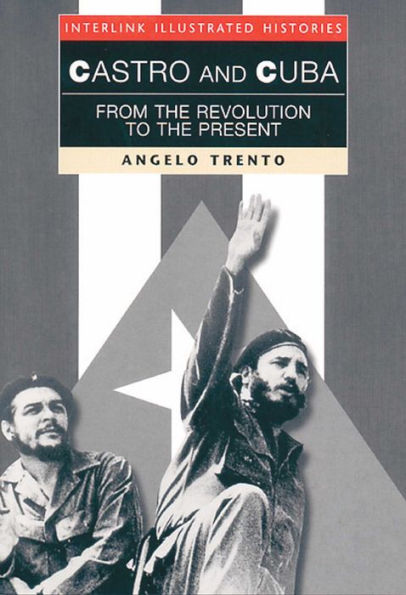5
1

Castro and Cuba (Interlink Illustrated Histories)
128
by Angelo Trento, Arthur Figliola (Translator)
Angelo Trento

Castro and Cuba (Interlink Illustrated Histories)
128
by Angelo Trento, Arthur Figliola (Translator)
Angelo Trento
Paperback
$15.00
-
PICK UP IN STORECheck Availability at Nearby Stores
Available within 2 business hours
Related collections and offers
15.0
In Stock
Overview
On January 1, 1959, Castro's followers entered Havana. The guerrillas took power and the "socialism of the tropics" began. Today, although the Castro regime has introduced some openings to a market economy, the island continues to wage a battle for its survival as the only socialist regime in the Americas. This concise history, which begins with the seizing of independence in 1898 and reaches to the present day, synthesizes the events that have made Cuba a singular case in the history of communism: the choice of socialism by Fidel and the missile crisis of 1962; the internationalism of Ernesto "Che" Guevara and Havana's maverick foreign policy; the adoption of the Soviet model and its effect on Cuba's social and economic life; the forms of the poder popular; the period after the fall of the Berlin Wall and the break with Moscow; and the difficulties created by the continuing economic embargo and the historical hostility of the United States.

Product Details
| ISBN-13: | 9781566563390 |
|---|---|
| Publisher: | Interlink Publishing Group, Incorporated |
| Publication date: | 08/01/2000 |
| Series: | Interlink Illustrated Histories |
| Pages: | 128 |
| Product dimensions: | 5.13(w) x 7.63(h) x (d) |
About the Author
Angelo Trento teaches Latin American History at the Instituto Universitario Orientale in Naples. He is the author of Brazil and co-author of Latin America in the 20th Century.
Table of Contents
| Chapter 1 | From Independence to the Revolution | 8 |
| An Unequal War between Spain and the United States | 11 | |
| The Prison of Sugar | 14 | |
| Political Distortions | 16 | |
| The Journey of Fidel Castro | 20 | |
| Cuba on the Eve of Revolution | 21 | |
| The Guerrilla Warfare of the Barbudos | 23 | |
| Work on the Slave Plantation | 12 | |
| Military Occupation and Economic Expansion | 16 | |
| Political Malpractice | 18 | |
| The General Principles of Guerrilla Warfare | 28 | |
| The Guerrillas on Balance | 29 | |
| Chapter 2 | Caribbean Socialism | 30 |
| Moralizing, Modernization, and Voluntarism | 32 | |
| Tensions and Divisions | 37 | |
| On the Brink of Tragedy: The Bay of Pigs and the Missile Crisis | 41 | |
| Structures Supporting the Revolution | 46 | |
| The Dream of the "New Man" | 48 | |
| The Return to Sugar | 52 | |
| 1961: The US Embargo | 38 | |
| Doubts in the White House: October, 1962 | 45 | |
| Chapter 3 | Internationalism and Choosing Sides | 54 |
| The Third World and Solidarity | 55 | |
| Supporting the Armed Struggle | 58 | |
| Guevara in the Congo and Bolivia | 60 | |
| Rapprochement with Moscow and the New Latin American Policy | 65 | |
| The Revolutionary Offensive and the Harvest of 1970 | 68 | |
| Limits of the Internationalism of the 1960s | 58 | |
| Guevara and 1968 | 64 | |
| The Failure of the Latin American Guerrilla Movement | 68 | |
| Workers and Small Merchants | 70 | |
| Chapter 4 | Economic Growth and the Soviet Model | 72 |
| The Directions of Economic Policy | 74 | |
| The Party: Mass Organizations and Institutions | 79 | |
| Dissent and Discontent | 83 | |
| Renewed Internationalist Zeal | 86 | |
| Rates of Economic Growth: 1970-1985 | 74 | |
| Poder Popular | 80 | |
| Chapter 5 | A New Road | 94 |
| The Strategy of "Rectification of Errors" | 96 | |
| The Trial of General Ochoa | 99 | |
| Tensions with Moscow and Washington | 103 | |
| What to do? | 97 | |
| Restive Youth | 100 | |
| Chapter 6 | Embargo, the Fall of the Ussr, and Economic Openness | 106 |
| The "Special Period" | 107 | |
| The Crisis of the Balseros, or Boat People | 109 | |
| The Opening to Foreign Capital and Economic Reform | 110 | |
| Hardening of the US Position | 114 | |
| An Intense Period of Diplomacy | 118 | |
| Between Political Openings and Closings | 119 | |
| Reforms, Warnings, and Regrets | 113 | |
| The Terms of the Embargo | 116 | |
| Resentment Created by Tourism | 117 | |
| The Sirens of Consumer Society | 122 | |
| Bibliography | 124 | |
| Chronology | 125 | |
| Index of Names | 127 |
From the B&N Reads Blog
Page 1 of
